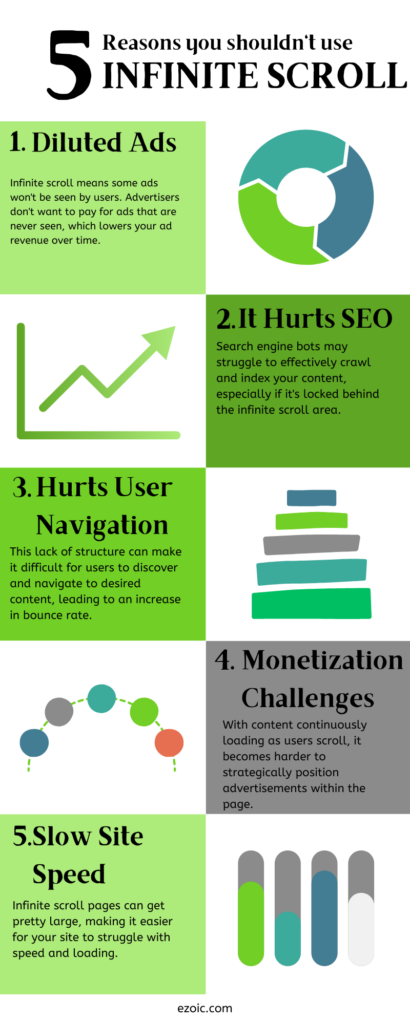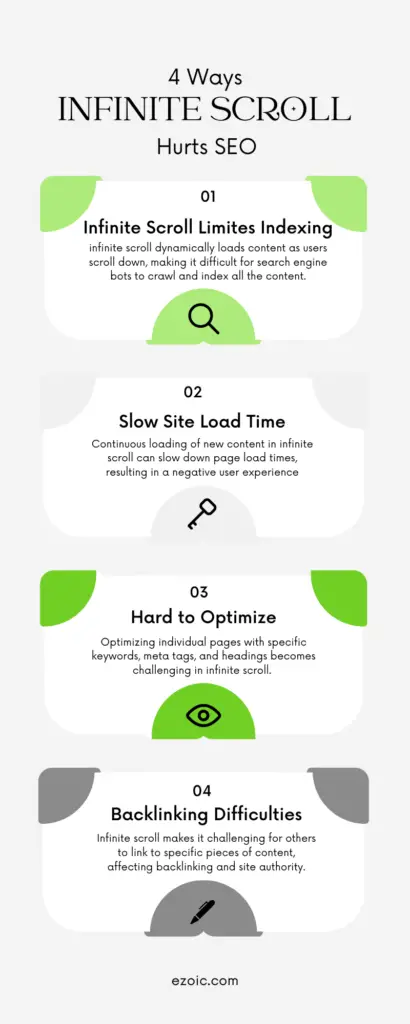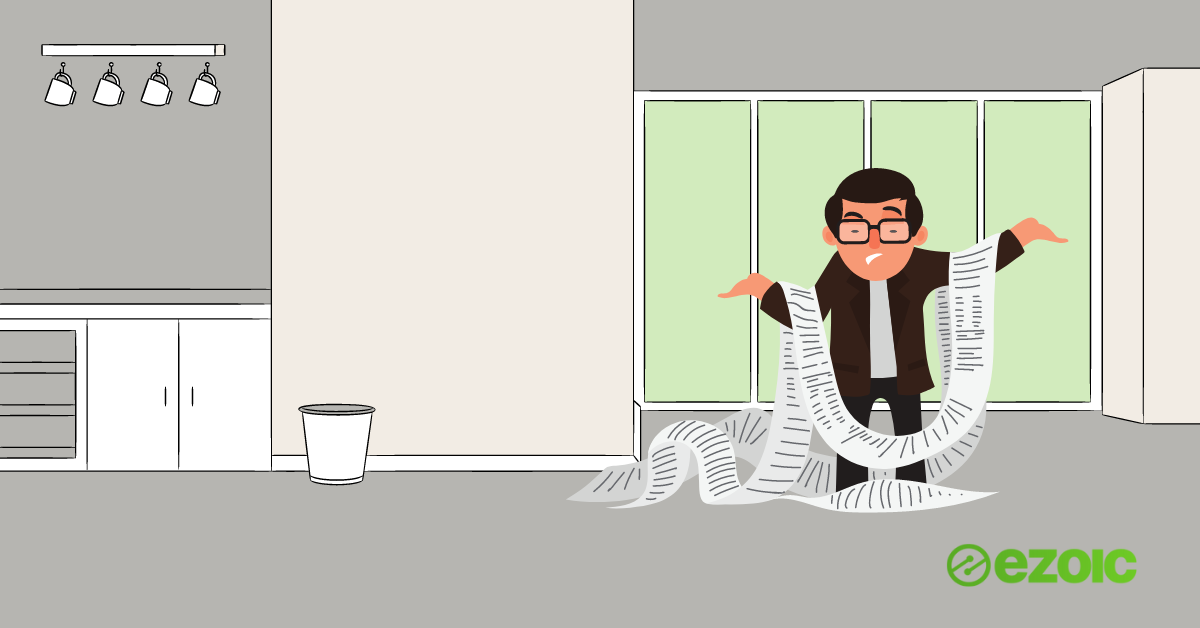Infinite Scroll (IS) has become the absolute standard for nearly every social media platform and high-trafficked website. It’s convenient, widely-accepted, and has shown to have a great impact on metrics like decreased bounce rate, increased time on site, and a smoother browsing experience for users, “Especially on mobile devices, where users have grown accustomed to swiping with their thumbs, rather than pecking at buttons, to fetch additional content.”
But upon closer look of the metrics, SEO implications, user experience, and overall revenue for a site, using infinite scroll on a site is almost always detrimental to a site’s success. As you’ll see, the drawbacks of infinite scroll heavily outweigh its benefits, resulting in a poor user experience, stunted SEO growth, and overall decreased site revenue.
Here’s why infinite scroll hurts user experience, traffic, and site revenue.

Your Ads Become Diluted (and Unviewable)
It’s not uncommon to see a jump in advertisements and revenue on the first day or so after implementing infinite scroll on your site.
But this isn’t sustainable; in fact, the decline in overall ad revenue has already begun.
Why? Here’s a basic overview of what happens after you implement infinite scroll on your site. A visitor comes to your site, which triggers the ads to load. The user scrolls, then another URL or pagination occurs…now more ads load (and perhaps the top of page ads refresh). But since the user is still scrolling, they don’t see these refreshed or new ads, even though they’re still on the page — they’re too far down to see them. This means more ads become unviewable, and the number of unviewable ads served across a session increases, too.
Now consider a site with pagination (where a user clicks from page to page to see more content). A visitor comes to your page, which triggers the ads to load. Then, the user clicks to a new page, causing more ads to load (and possibly the top of page ads to simply refresh). This means increased ad impressions and higher potential for ad CTR, as all ads are viewed by the user.
What does all this mean? The day infinite scroll is implemented, it does indeed mean more ads (and an immediate — but temporary) spike in ad revenue. Over the course of the following weeks and months, the value of every ad impression becomes badly diluted.
This leads to a new host of problems. Advertisers set limits on sites and visitors, and routinely blacklist sites with poor viewability ratios. They also track the bids-to-impression ratios (meaning: why would they bid high if they knew that a site was going to serve 45 ads across a session? Might as well bid low and take their chances).
Infinite scroll leads to decreased value of ad impressions, which means lowered revenue, a poorer user experience, and a decline in overall site success.
But that’s not all. There are other negative implications infinite scroll has on sites.
Infinite Scroll and SEO: How It Can Hurt Your Search Rankings
Infinite scroll can bring several unintended consequences to a site, namely a drop in SEO. There are several ways infinite scroll hurts a site’s SEO and makes it more difficult to show up in search rankings, an already-difficult task.
First, infinite scroll limits indexing. Unlike traditional pagination, where each page has a unique URL, infinite scroll loads new content dynamically as users scroll down. Consequently, search engine bots may struggle to effectively crawl and index all the content, leading to incomplete indexing and reduced visibility in search results. Simply put: infinite scroll makes it harder for search engines to find your content locked away in the infinite scroll.
Next, can massively slow down site load time and a user’s experience, vital for SEO. Continuous loading of new content can cause longer page load times, resulting in a poor user experience (and more importantly, a lowered SEO ranking). Slow-loading pages can lead to higher bounce rates, lower engagement, and ultimately, lower search rankings. Additionally, users may find it difficult to navigate and locate specific content, impacting their satisfaction and the likelihood of returning to your site.
Just optimizing an infinite scroll page can be a challenge. Unlike traditional paginated structures, where individual pages can be optimized with specific keywords, meta tags, and headings, infinite scroll dynamically loads content, making it difficult to uniformly apply these optimizations. This can dilute keyword relevance and hinder search engines from understanding the contextual relevance of the content. SEO is hard enough without making it more difficult through tricky infinite scroll SEO strategies!
One of the biggest ways infinite scroll hurts SEO is with backlinking and social sharing. With continuous content loading on a single URL, it becomes challenging for others to link to specific pieces of content (and if they do link to an infinite scroll page, there’s an almost-zero chance the correct content will display when a user clicks on the backlink).
Backlinks are crucial for SEO, and when others cannot easily reference your content, it can affect your site’s authority and visibility. Similarly, social sharing becomes more complicated, as users might share the main URL, missing out on the opportunity to highlight specific content.
Martin Splitt, member of Google’s Search team, explained that the Googlebot does not scroll through these infinite pages. “What does Googlebot not do? It doesn’t scroll.” It’s unthinkable for any savvy site owner to consider using a site tool that prevents Google from looking at their site, guaranteeing the site content isn’t indexed for Google search. Infinite scroll hinders indexing and ranking, and should not be used for the vast majority of websites.

Why Infinite Scroll Hinders Content Discoverability and User Navigation
Many publishers and site owners think that the convenience of infinite scroll outweighs any cons or drawbacks. Unfortunately, the list of ways infinite scroll can hurt your site continues to grow.
Infinite scroll hinders content discoverability and user navigation for several reasons:
The lack of clear page divisions presents a clear reason why user experience suffers in an infinite scroll site. Infinite scroll eliminates the traditional pagination system, where content is divided into distinct pages; without clear page divisions, it becomes challenging for users to gauge how much content exists and where specific articles or information are located. This lack of structure can make it difficult for users to discover and navigate to desired content, leading to an increase in bounce rate.
Infinite scroll also offers limited control over navigation options a user can do. Users typically have two options: continuously scroll down or reach the end of the content. This lack of control can be frustrating, especially when users want to jump to a specific section or revisit a previous article. It can lead to a sense of disorientation and hinder their ability to navigate the site effectively, leading to poor user experience and lowered SEO rankings.
With infinite scroll, there are often no visible indicators of progress or how much content is left to explore. Users may feel uncertain about how far they’ve scrolled or how much more content remains. This lack of feedback can also be disorienting and make it difficult for users to gauge their progress or estimate the time required to reach desired content.
Infinite scroll makes it challenging for users to revisit or reference specific content they have previously seen, a crucial part of research, backlinking, sharing, and revisiting site content. Since there are no clear page divisions or direct links to individual posts, users may need to rely on their memory or perform time-consuming scrolling to find a particular article. This lack of efficient content retrieval can be frustrating and discourage users from engaging with your website.
Furthermore, infinite scroll often requires users to rely heavily on scrolling, reducing the effectiveness of browser functions such as the back button, bookmarking, or sharing specific URLs. These browser functionalities play a crucial role in content discovery, organization, and sharing, not to mention traffic and page view numbers, and their limitations can hinder user navigation and make it harder for users to interact with your content.
To mitigate these challenges, alternative navigation options, such as sticky navigation menus, search bars, or a combination of infinite scroll and traditional pagination, can be considered to enhance content discoverability and user navigation on your website. Overall, infinite scroll continues to make user experience poorer and navigation more difficult.
The Revenue Pitfalls of Infinite Scroll: Advertisements and Monetization Challenges
Many publishers and site owners have a vision for their site in mind; they imagine a seamless user experience, high-trafficked site with potential for viral content. This might include integrating infinite scroll features, much like the most popular and highest-trafficked online communities like social media apps.
But the metrics and numbers do not lie. Infinite scroll almost always has a negative impact on traffic and revenue, due to their unique effect on advertisements and monetization structures on the site. Here are just a few ways this can occur.
Infinite scroll poses challenges in terms of ad placement and visibility. With content continuously loading as users scroll, it becomes harder to strategically position advertisements within the page. Ads that are not prominently placed or easily visible may experience lower click-through rates and subsequently impact revenue generation (advertisers are likely to bid less on ads that get lowered impression and view metrics on a site). Moreover, the dynamic nature of infinite scroll can lead to ad viewability issues, as ads may appear briefly and then be pushed out of view, reducing their effectiveness.
Next, the constant loading of new content in infinite scroll can negatively impact ad loading and page performance. Ads that need to load with each new content section can slow down page loading times, resulting in a subpar user experience. Slow-loading pages can lead to higher bounce rates and decreased engagement, ultimately affecting ad impressions and revenue potential. Balancing the need for ad loading efficiency with seamless scrolling can be a significant challenge for website owners.
Infinite scroll can also impact ad density and user experience. and not in a good way. As users continuously scroll, the frequency of ads displayed may increase significantly, potentially overwhelming visitors and detracting from their overall experience. Intrusive or excessive advertising can lead to frustration, higher ad-blocking rates, and a decline in user engagement. Striking the right balance between generating revenue and maintaining a positive user experience is crucial for sustained monetization success.
Optimizing monetization strategies within an infinite scroll framework can be complex. Website owners need to carefully consider how ads are integrated into the scrolling experience to maximize revenue without compromising user satisfaction, and how infinite scroll can have such a negative impact from a logistical and site structure framework.
This may involve experimenting with different ad formats, sizes, and placements to identify what works best for both users and advertisers. Additionally, implementing techniques such as lazy loading and asynchronous ad loading can help improve page performance and overall revenue potential.
While infinite scroll offers a seamless browsing experience, it presents challenges when it comes to generating revenue through advertisements and website monetization, often hurting a site’s performance, user experience, and revenue. The placement and visibility of ads, ad loading and page performance, ad density, and finding the right monetization strategies are all critical factors that website owners must consider.
By carefully balancing user experience and revenue generation (something Ezoic does automatically for you), bloggers and website owners can make their site a truly thriving online community with consistent traffic that can rely on a great user experience.
Load Time Woes: How Infinite Scroll Can Slow Down Your Website
Another key metric used by your audience and search engines alike to make decisions about your site is your site’s load time. As Sematext explained, “Google uses web page loading time as a direct ranking factor, influencing a page’s position in the search results.” Google looks down on slow load times, and uses this metric as a major factor in SEO.
The same goes for the actual people viewing your site; as Markettailor reaffirms, “Website load time is an important aspect of the user experience because it directly impacts the user’s perception of the website.” In a user’s mind, a slow site means a low-quality site. Slow load times are almost always correlated with a lower perception of a site’s quality. Even a mere 2-seconds(!) in load time can cause nearly 90% of site visitors to leave and abandon the site.
Infinite scroll can slow down your site’s load times. In an internet landscape where every tenth of a second counts for a user’s perception, these slow load times can spell doom for site owners.
There’s also the effect content overload can have. With infinite scroll, new content continuously loads as users scroll down, leading to an accumulation of data on a single page; as the page becomes content-heavy, it can significantly increase the load time. The larger the page size, the longer it takes for the browser to download and render all the elements, such as images, videos, and interactive features. This can result in frustratingly slow load times, leading to user dissatisfaction and potential abandonment of the website.
Infinite scroll also often relies on AJAX or similar technologies to load new content dynamically without refreshing the entire page. Each time new content is loaded, it requires additional HTTP requests to fetch the data from the server, further burdening the site’s resources. As the user continues scrolling, these requests accumulate, potentially causing a high number of server round trips and further slowing down the website. The increased latency can adversely affect the load time, especially for users with slower internet connections or accessing the website from mobile devices (which has become an increasing majority for average internet traffic metrics).
Many site owners also don’t realize that infinite scroll heavily relies on JavaScript to handle the dynamic loading of content. As the user scrolls, JavaScript code executes to trigger the retrieval and rendering of new content. However, excessive JavaScript execution can significantly impact the website’s performance. JavaScript files need to be downloaded, parsed, and executed by the browser, which consumes processing power and can lead to delays in rendering and responsiveness. This can result in sluggish scrolling and overall slower website performance.
While infinite scroll offers a visually appealing and engaging browsing experience, it can come at the cost of slower website load times. The accumulation of content, increased HTTP requests, JavaScript execution, and the SEO implications of slow-loading pages are all factors to consider. It’s essential for website owners to find a balance between the benefits of infinite scroll and the potential negative impact on load times. Optimizing code, minimizing content overload, and implementing caching techniques can help mitigate the load time woes associated with infinite scroll, ensuring a faster and more satisfying user experience.
In Conclusion
“By hiding much of your content on a page and loading it only when requested by scroll, infinite scroll might prevent proper indexing of your content by search engines. This lowers your site’s chances of ranking on results pages.” –Hubspot
Putting infinite scroll features on a new site can have some decent short-term benefits and spikes in traffic and revenue, but over the following weeks and months, the results usually diminish. The lowered ad visibility, paired with some ads simply becoming unviewable, commonly result in advertisers bidding lower and lower based on your site’s lowered ad visibility.
Potential site convenience comes at the cost of lowered ad impressions, lower ad CTR, and lower ad revenue over time.


